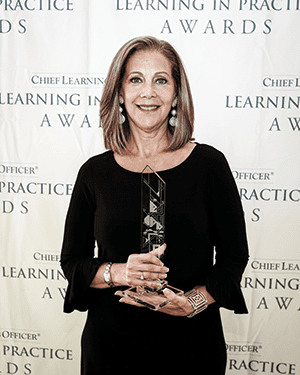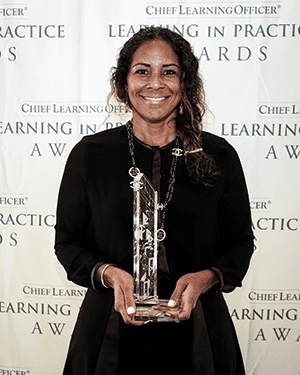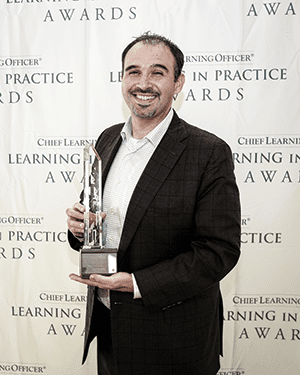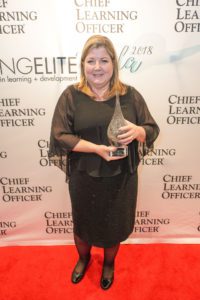For learning executives who have demonstrated exceptional business acumen combined with forward-looking vision to develop and execute a comprehensive learning strategy that clearly aligns employee development with broader organizational strategy.
DIVISION 1
Daniel Gandarilla
Vice President, Chief Learning Officer, Texas Health Resources
In 2015, CEO Barclay Berdan challenged each leader at Texas Health Resources to identify ways that they could make their functions more affordable, innovative and reliable. In response, Daniel Gandarilla rose to that challenge and examined how learning could preserve the health care company’s high quality while still reducing costs and revamping the way that learning operates.
Knowing that money spent in learning and development impacts customer cost, Gandarilla identified the overall cost for staff L&D to make health care more affordable and optimized the structure. To make it more innovative, they moved to standardize web-based training and developed a 10-year learning road map that identifies new technologies to transform learning and manage academic partners more effectively. Finally, the task of firmer reliability was met through programs to reduce error and standardize processes of care and clinical outcomes.
Gandarilla and the team interviewed multiple stakeholders to understand the primary issues and areas for improvements such as a lack of communication, limited resources and a lack of standardization of practice in specific areas like electronic health record training. All of this led to the creation of a corporate university to enable talent at all levels to fulfill the company’s mission and vision, execute on initiatives and fulfill their promise through positive leadership behaviors.
Michelle Braden
Chief Learning Officer, TELUS International
After doubling in size from 13,000 to 26,000 employees, TELUS International found three primary challenges they needed to address: navigating the company’s evolution from a primarily Canadian telecom to a global company, putting customers first and creating a culture of engagement.
Michelle Braden led the company to create the Learning@TI Roadmap. The program works at all organizational levels to help Telus grow in those key areas regardless of a person’s role or location within the company. Programs like IExcel and ILead are designed for senior leaders, while IAspire is designed to help employees move into leadership positions.
Since implementation, engagement levels have gone up 5 percent, earning the company Best Employer status from Aon Hewitt.
Chris Hall
Assistant Commissioner, Office of Training and Development, U.S. Customs and Border Protection
Led by Chris Hall, the U.S. Customs and Border Protection Office of Training and Development reworked their Senior Executive Leadership program. After finding a lack of alignment between the senior leadership executive core competencies, Federal Employee Viewpoint Survey Scores and the current leadership programs, Hall and his team created a leadership program that would address issues like unclear expectations of leaders and skills gaps in senior leadership positions. Since the program began survey scores showed a significant uptick.
Kavita Kurup
Head, Learning and Organizational Development, Axis Bank
At India-based Axis Bank, Kavita Kurup saw the need for work in several areas, including performance management and people and career development. The resulting ACELerate program integrates performance with capability development and blends new methods, traditional instructor-led sessions and “drip-feed” learning so Axis Bank employees can learn at their own pace. The result is a program to help employees develop skills that align with the company’s competencies but also allows them to grow individually.
DIVISION 2
Stephen Parker
Chief Learning Officer and Head of Talent Management, A.T. Kearney
When Stephen Parker became A.T. Kearney’s first ever chief learning officer, his first task was to lead a curriculum overhaul and redesign the learning function. The Chicago-based management consulting firm’s goal was to introduce a fresh vision and become the industry’s most admired firm.
Parker started with understanding the company’s values, culture and ambitions in order to create a strategy that put learning at the forefront of business. Though initially focused on growing the skills and performance of consultants, Parker found the bigger picture goal was to transform company culture.
He zeroed in on specific learning strategies to meet these goals. First was compelling delivery. Prior to Parker joining the team, learning was taking place in dimly lit conference rooms where more often than not it was led by instructors who had just participated in the program. Parker enlisted senior consultants to share their expertise and moved the program to fresh venues in order to increase engagement.
Another strategy was to create a comprehensive learning journey. Training days had been sporadic and disconnected so Parker designed a schedule to connect the company globally and create spaces to celebrate connection and culture.
These changes in curriculum have allowed leaders to be more successful and better equipped to deal with clients. The programs have boosted results on the firm’s internal survey with 85 percent of respondents now saying the company is influencing their personal growth and development through learning.
Melissa Janis
Vice President, Leadership and Organizational Development, McGraw-Hill Education
In 2014, David Levin, the newly appointed CEO of McGraw-Hill Education, charted a new path for the company then best known as a textbook publisher. Levin wanted McGraw-Hill to become a learning science company and provide a platform for digital education services.
It was a daunting change especially for a 125-year-old company deeply rooted in its history and legacy. The new mission required transformation at all levels starting with the individual perspectives of senior leaders.
In response, Melissa Janis developed Catalyst, a leadership development program to transform culture and ultimately carry through the transformation of McGraw-Hill Education’s business strategy. Catalyst included 360-degree leadership assessments with coaching, feedback and mentoring and was instrumental in changing leadership attitudes and behaviors to align to the company’s new mission.
Cherie Matthews
Vice President, Leadership and Talent Development, Capital Group 
Faced with an ever-evolving business environment, Cherie Matthews implemented a new leadership strategy at Capital Group, a Los Angeles-based financial services company. The new program included revamped initiatives for the firm’s top 120 leaders as well as first-level and senior managers. Central to the initiatives was support for continuous learning. The programs ultimately led to higher employee engagement and leadership growth.
Marygrace Schumann is an editorial intern at Chief Learning Officer magazine. She can be reached at editor@CLOmedia.com.






















